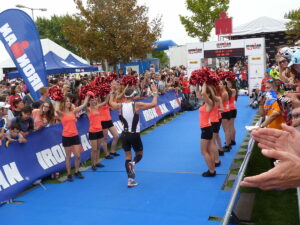Few athletic endeavors test the limits of human grit and endurance like the Ironman triathlon. Widely regarded as one of the most grueling challenges in sports, the Ironman demands competitors to push through a 2.4-mile open water swim, a 112-mile bike ride, and a full marathon – 26.2 miles – all in a single day. This extraordinary event is not

only a race against time, but also a personal battle against fatigue, mental exhaustion, and self-doubt.
Since its inception in Hawaii in 1978, the Ironman has grown into a global phenomenon, attracting athletes from all walks of life. Some come to chase personal records, while others simply seek to finish – proving that the Ironman is about much more than physical strength. It’s about grit, resilience, and the unrelenting pursuit of what lies beyond perceived limits.
In this blog, we’ll review the history of Ironman races, explore what it takes to train for such a demanding event, and uncover the mental and physical strategies that have led athletes to cross the finish line. Whether you’re an endurance athlete or someone seeking inspiration from these incredible competitors, the Ironman triathlon offers lessons in discipline, perseverance, and the relentless will to succeed.
The History of Ironman Races
The Ironman triathlon has its roots in a bold experiment born out of a simple question: which athletes are the fittest – swimmers, cyclists, or runners? This question sparked a debate among athletes stationed in Hawaii in the late 1970s, leading to the creation of an event that would settle the score. Navy Commander John Collins proposed a race combining the island’s existing long-distance competitions: the Waikiki Roughwater Swim (2.4 miles), the Around-Oahu Bike Race (112 miles), and the Honolulu Marathon (26.2 miles). His simple declaration, “Whoever finishes first, we’ll call him the Iron Man,” gave birth to a legendary event.
In February 1978, 15 men took on the first Ironman challenge, not knowing if it was even possible to complete all three endurance events in succession. Only 12 finished, but the story of their extraordinary efforts quickly spread, igniting interest far beyond the shores of Hawaii.
What began as an underground challenge for a handful of athletes has since grown into a global event, with Ironman-branded competitions held across continents. The annual Ironman World Championship, held in Kona, Hawaii, remains the pinnacle of the sport, attracting elite athletes and weekend warriors alike. The race’s history is a testament to human resilience and the belief that with the right mindset, anything is possible.
What It Takes to Train for Ironman
Training for an Ironman race is nothing short of a monumental commitment. Preparing for the 140.6-mile journey across three disciplines – swimming, cycling, and running – requires months, often a year or more, of rigorous training. The physical demands are immense, but the mental endurance required is equally challenging.
A typical Ironman training program consists of daily workouts designed to gradually build endurance, strength, and speed. Athletes often spend hours each week in the pool dialing in their stroke, logging hundreds of miles on the bike, and running for varying distances to prepare their bodies for the marathon leg. It’s not uncommon for Ironman competitors to train upwards of 15-20 hours a week in the months leading up to race day.
varying distances to prepare their bodies for the marathon leg. It’s not uncommon for Ironman competitors to train upwards of 15-20 hours a week in the months leading up to race day.
Balancing intensity with recovery is just as important. Ironman athletes have to strategically master the art of pushing their limits without overtraining, as injuries from burnout can easily derail months of preparation. Recovery strategies – like proper sleep, stretching, and active rest days – are vital for preventing fatigue and keeping the body primed for peak performance.
Beyond the physical, mental resilience is key. Ironman competitors face long, lonely training sessions where motivation can be tough to find and doubt easily creeps in. Staying focused on the ultimate goal, finding a training routine that works with life’s other demands, and learning to embrace the inherent discomfort are essential components of successfully preparing for race day. The grueling nature of the event forces athletes to develop an ironclad mindset to stay disciplined and overcome the inevitable roadblocks along the way.
Ultimately, training for an Ironman is a holistic journey, demanding a delicate balance of physical conditioning, mental strength, and sheer determination.
Nutrition and Hydration Strategies for Ironman Competitors
Fueling the body properly is just as important as physical training when preparing for an Ironman race. Given the extreme duration and intensity of the event, athletes must have a well-planned nutrition and hydration strategy to keep energy levels up and avoid fatigue, cramping, or worse – hitting the dreaded “wall.” For Ironman competitors, what they eat and drink before, during, and after the race can make or break their performance.

In the months leading up to race day, nutrition becomes a critical part of training. Athletes typically focus on a balanced diet rich in carbohydrates for fuel, healthy fats for sustained energy, and ample protein for muscle recovery. Nutrient timing is key – eating the right foods before and after workouts helps optimize energy levels and muscle repair. Carb-loading in the days leading up to the race is a common practice, ensuring the body’s glycogen stores are fully stocked for race day.
During the race itself, competitors must consume enough calories to keep up with the massive energy expenditure. The challenge is finding a balance: too few calories can lead to exhaustion, while too many or the wrong kinds of fuel can cause gastrointestinal distress. Many Ironman athletes rely on energy gels, bars, and electrolyte drinks to provide quick-digesting carbs, while also making sure to hydrate consistently. Hydration is especially crucial, as dehydration can lead to cramping, heat exhaustion, or even a dangerous condition called hyponatremia – when sodium levels in the body drop too low from overhydration without replenishing electrolytes.
electrolyte drinks to provide quick-digesting carbs, while also making sure to hydrate consistently. Hydration is especially crucial, as dehydration can lead to cramping, heat exhaustion, or even a dangerous condition called hyponatremia – when sodium levels in the body drop too low from overhydration without replenishing electrolytes.
Post-race nutrition focuses on recovery. Protein is critical to repair muscle damage, while carbohydrates help restore depleted glycogen stores. Rehydration is equally important to replace fluids lost during the event, and athletes often use this time to reflect on their nutrition plan—what worked and what needs adjustment for future races.
Ultimately, Ironman nutrition isn’t just about what you eat on race day. It’s a long-term strategy that involves fueling correctly during training, testing different approaches, and finding what works best for your body. Those who master the art of nutrition and hydration give themselves a significant advantage in crossing the Ironman finish line strong.
Overcoming The Mental Barriers to Finishing an Ironman
While physical training is essential for completing an Ironman, mental strength is often what separates those who finish from those who fall short. The Ironman race is not just a test of physical endurance but also a battle of the mind. Competitors face hours of physical pain, mental fatigue, and moments of self-doubt that push them to their limits. It’s in these moments that the mental game becomes critical.
Ironman athletes regularly talk about experiencing “dark moments” during the race – times when exhaustion sets in, and the mind starts questioning whether they can continue. This mental fatigue can creep in during the swim, cycling, or marathon stages, as the sheer length of the event forces participants to dig deep into their psychological reserves. Training the mind to overcome these inevitable low points is just as important as training the body.
Visualization techniques are one of the most powerful mental tools Ironman athletes use. Many spend months mentally rehearsing the race, visualizing themselves overcoming challenges, pushing through fatigue, and crossing the finish line. This mental imagery prepares them to stay focused and calm, especially when things don’t go according to plan.
Another key to overcoming mental barriers is breaking the race into smaller, manageable segments. Rather than focusing on the enormity of the entire race, competitors often focus on getting to the next buoy, the next aid station, or the next mile marker. This mental strategy helps reduce the overwhelming feeling of the race and keeps athletes motivated to push through each segment.
Support from the Ironman community, whether from family, friends, or fellow competitors, also plays a huge role in boosting morale. Encouraging words from the sidelines or a brief moment of connection with another athlete on the course can provide a powerful reminder that they are not alone in their struggle.
In the end, finishing an Ironman is as much a victory of willpower as it is a physical achievement. The race teaches athletes how to stay present in the moment, how to quiet the voice of doubt, and how to keep moving forward, no matter how tough things get. For many competitors, it’s these mental battles that leave the most lasting impression long after the race is over.
The Global Ironman Community
One of the most powerful aspects of Ironman races is the sense of camaraderie they foster. Despite the individual nature of the sport, Ironman competitors share a unique bond, driven by the collective challenge of pushing their physical and mental limits. Whether you’re an elite athlete chasing a podium finish or a first-time participant, the encouragement and support from fellow competitors are powerful aspects of the race.

The Ironman community extends far beyond race day. Training clubs, online groups, and social networks connect athletes from around the world, creating a global family that shares advice, inspiration, and motivation. The iconic Ironman World Championship in Kona, Hawaii, is a testament to this spirit, where the world’s best come together to compete, but also to celebrate each other’s journeys.
For many, Ironman isn’t just a race – it’s a deep experience that unites unique people across borders, building a lasting sense of community and support long after the finish line is crossed.
Conclusion
Ironman races are grueling physical challenges, but they stand as so much more than a simple test of endurance – they represent the ultimate challenge of human willpower and resilience. From their humble beginnings in Hawaii to becoming a global phenomenon, these races push athletes to their absolute limits, both physically and mentally. The rigorous training, strategic nutrition, and ability to overcome intense mental barriers all culminate in an event that has captivated athletes and spectators alike.
For those who dare to take on the challenge, the Ironman offers an unparalleled sense of accomplishment and a deep connection to a community that celebrates perseverance. Whether you’re looking to push your personal boundaries or simply gain insight from the stories of Ironman competitors, the lessons from this race extend far beyond the finish line.
If you’re inspired to try an Ironman, or simply curious about the experience, remember that it’s not just about completing the race – it’s about discovering what you’re truly made of along the way.








